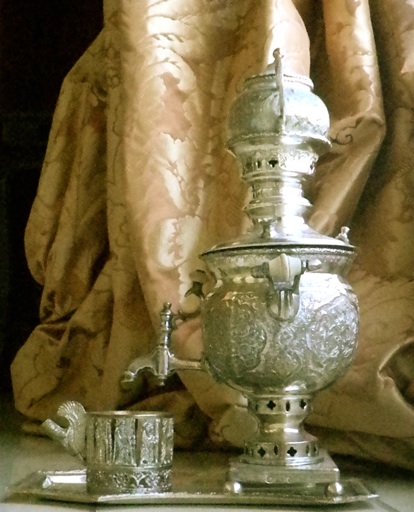

In this photo: Samovar (Courtesy Dora Levy Mossanen)
I had 15 minutes to kill before a lunch appointment, so I stepped into American Tea Room in Beverly Hills. This is my favorite destination to purchase all types of sumptuous teas. It was raining outside, and I poured myself a cup of lavender tea, enjoying the aroma, the pleasant warmth.
There are canisters brimming with high-caffeinated, medium, or none-caffeinated tea leaves, teas that will cleanse, energize, calm, or promote sleep. Teas for different times of the day -- Yerba Mate for its stimulating effect in the morning (this I learned from Dr. Oz), Bi Luo Chong green tea with a nutty flavor for late morning (this one I find cleansing), refreshing peppermint to enhance digestion, Long Jing green tea, harvested from top of the Tian Mu mountains, light in caffeine for early afternoons, and my favorite: golden chamomile blossoms from Egypt to calm and relax in the evening. efore you think I'm some kind of a tea-crazed woman, let me explain that the origin of my love affair with tea goes years back to when I lived in Iran.
In Iran business meetings, signing of agreements, promises of marriage, reaffirmation of vows and friendships, renunciations of love or loyalty, and above all, divulging of the most guarded secrets, are conducted over a cup of steaming tea.
Fine tea is like premium wine. The color and bouquet are important. When held up to the light, tea must not be too weak so that light passes through without exposing the character, nor too dark to conceal the cognac gleam of its heart.
Aromatic leaves of the highest quality are selected, preferably from mountainous regions, where the plants grow slowly, allowing time for the complex flavors to develop. A multitude of herbs and spices, cardamom, peppermint, ginger, black currant, mint, jasmine, or rose petals add a pleasing aroma.
The process of brewing tea is a delicate art of precision and control that requires the proper accouterments. Water in a silver samovar must reach a boiling point before being poured over tealeaves in a china pot. Once the leaves are submerged in hot water, the teapot, filled to three-fourths, is placed on the neck of the samovar to brew for no less than 15 minutes and no more than 25, or the color will turn muddy, rendering the tea worthless.
Narrow-waisted glasses with filigreed holders are preferable. Set on small saucers with miniature spoons to the right of the glass. Glasses must be arranged in perfect order on a tray, the handles facing guests, the tray held low and at a comfortable serving level.
Tea must never, ever be served lukewarm or cold, not only because the heat soothes the throat and stomach as the liquid is sipped through a sugar cube, but because boiled water is safe to drink in any village or out of way hamlet.
Above all, it is rude to refuse tea. A glass of steaming tea has contributed to long lasting friendships and its refusal to raging conflicts and battles, such as the notorious Opium Wars. So, there you go! Take a deep breath and steep yourself a soothing cup of tea. Life is good!